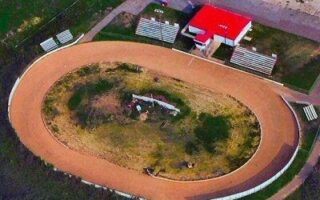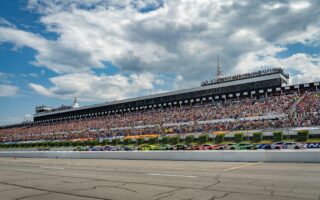Title: The Visionary Behind the Brickyard: A Look at Tony Hulman
In the heart of Indiana, where the roar of engines ignites the spirit of competition and the scent of gasoline hangs heavy in the air, one man’s influence endures beyond the racetrack. Tony Hulman, a name synonymous with the Indianapolis Motor Speedway, is a figure whose legacy is intertwined with the very fabric of American motorsport. Born into a prominent family in 1906, Hulman’s journey transformed him from a businessman into a beloved promoter, revitalizing a struggling institution into one of the world’s most iconic sporting venues—the Indianapolis 500. This article delves into the life and achievements of Tony Hulman, exploring how his vision and determination reshaped the landscape of racing, leaving an indelible mark that continues to inspire generations of fans and drivers alike. Join us as we navigate through the milestones of Hulman’s remarkable career and the enduring impact he has had on motorsports culture.
Table of Contents
- The Visionary Behind the Brickyard: Tony Hulmans Impact on Auto Racing
- Revitalizing Tradition: How Tony Hulman Reshaped the Indianapolis 500 Experience
- From Businessman to Legend: Analyzing Tony Hulmans Strategic Moves
- Legacy of Innovation: Recommendations for Future Leaders Inspired by Hulmans Journey
- Q&A
- To Conclude
The Visionary Behind the Brickyard: Tony Hulmans Impact on Auto Racing
Tony Hulman’s influence on the world of auto racing is both profound and far-reaching. Upon taking over the Indianapolis Motor Speedway in 1945, he transformed a struggling entity into a thriving hub of innovation and excitement. With his vision, Hulman revitalized the iconic raceway, ensuring that the Indianapolis 500 remained the crown jewel of motorsport. His strategies included modernizing facilities and enhancing the spectator experience, which attracted a new generation of fans. Under his guidance, the race evolved into an international phenomenon, drawing competitors and spectators from around the globe.
Beyond infrastructure, Hulman was a masterful promoter who understood the power of media and marketing in elevating the sport. He cultivated relationships with key figures in racing and leveraged emerging technologies to capture the imagination of audiences. Some of his key contributions can be highlighted as follows:
- Revamped Race Events: Initiated exciting pre- and post-race activities.
- Innovative Sponsorships: Pioneered partnerships that brought financial stability.
- Community Engagement: Fostered local interest through outreach and events.
In recognition of his significant contributions, Hulman was inducted into various Hall of Fames, solidifying his legacy as a true pioneer of auto racing. His commitment to excellence not only shaped the future of the Indianapolis 500 but also left an indelible mark on motorsport as a whole.
Revitalizing Tradition: How Tony Hulman Reshaped the Indianapolis 500 Experience
Tony Hulman’s acquisition of the Indianapolis Motor Speedway in 1945 marked a turning point in the storied history of the Indianapolis 500. With a vision that went beyond simply maintaining the race, he sought to breathe new life into a tradition that had faced stagnation during the Second World War. His dedication to revitalizing the event transformed the cultural landscape of auto racing, introducing modern influences while honoring the race’s rich heritage. Hulman’s emphasis on fan experience led to significant enhancements, including:
- Infrastructure Improvements: Upgrading facilities to accommodate larger audiences.
- Innovative Promotions: Implementing captivating pre-race events that attracted diverse crowds.
- Media Engagement: Expanding coverage to reach a broader audience through radio and television.
Hulman’s vision extended beyond physical changes; he fostered a sense of community and excitement that resonated with both avid fans and newcomers. By hosting events and celebrating the rich history of the Indianapolis 500, he made the race more accessible and inclusive. His legacy can be visualized through the transformation of the Indianapolis 500 into an American cultural phenomenon as seen in the following table:
| Year | Major Change | Impact |
|---|---|---|
| 1946 | Introduction of Victory Lane | Enhanced celebration for winners |
| 1950s | Media Rights Expansion | Increased national followership |
| 1960s | Major sponsorship deals | Financial stability and growth |
Through these innovations, Hulman not only preserved the legacy of the Indianapolis 500 but also set a precedent for its evolution into a major sporting spectacle. His commitment to blending tradition with modernity ensured that the event would thrive for generations, securing its place in the hearts of racing enthusiasts around the world.
From Businessman to Legend: Analyzing Tony Hulmans Strategic Moves
Tony Hulman, an astute businessman with a knack for turning challenges into opportunities, masterminded a series of strategic moves that not only revived the Indianapolis Motor Speedway but also cemented his legacy as a transformative figure in American motorsport. Upon acquiring the Speedway in 1945, he recognized the potential for growth and innovation. By investing in infrastructure and promoting a more inclusive approach to events, Hulman managed to attract a wider audience. His vision culminated in the revitalization of the Indianapolis 500, enhancing its status as the “Greatest Spectacle in Racing.” The deliberate blend of traditional elements with modern appeal set the stage for a renaissance that would captivate generations of fans.
Hulman’s emphasis on community engagement and sponsorships revolutionized the business dynamics of racing. Beyond simply promoting races, he recognized the importance of nurturing relationships with local businesses and sponsors. This strategic focus resulted in significant financial backing, allowing for advanced marketing strategies and improved race-day experiences. Hulman’s efforts not only increased attendance but also established a template for how sports franchises engage with their communities. As a result, his tactics laid the groundwork for future growth, not just at the Speedway, but across the motorsport industry as a whole.
Legacy of Innovation: Recommendations for Future Leaders Inspired by Hulmans Journey
The journey of Tony Hulman serves as a beacon for future leaders aiming to cultivate a legacy of innovation in their respective fields. His ability to envision potential where others saw limitations highlights the importance of adaptability and foresight. Aspiring leaders should embrace a mindset that views challenges as opportunities for growth. This includes investing time in understanding the nuances of their industries and cultivating relationships with stakeholders to foster collaboration. Key aspects of Hulman’s approach include:
- Visionary Thinking: Always keep a long-term perspective that aligns with both personal and organizational goals.
- Community Engagement: Prioritize building relationships and engaging with the community to create a sense of belonging.
- Embrace Change: Regularly assess environments for changes and adapt business strategies accordingly.
Furthermore, leadership requires an inherent understanding of the transformative power of innovation. To inspire teams and propel initiatives forward, leaders should champion an ethos of experimentation and creativity. Fostering a culture that encourages risk-taking while managing failures as learning opportunities can lead to groundbreaking developments. Consider integrating the following principles into your leadership strategy:
| Principle | Description |
|---|---|
| Continuous Learning | Encourage team members to pursue knowledge and skills that enhance both their personal and professional growth. |
| Diversity of Ideas | Integrate varied perspectives to stimulate creativity and drive innovative solutions. |
| Resilience | Instill a culture that values persistence in the face of adversity. |
Q&A
Q&A: Exploring the Life and Legacy of Tony Hulman
Q: Who was Tony Hulman?
A: Tony Hulman was an American businessman and the visionary behind the revitalization of the Indianapolis Motor Speedway. Born on March 31, 1901, he became a pivotal figure in American motorsports after acquiring the track in 1945.
Q: How did Hulman come to own the Indianapolis Motor Speedway?
A: After World War II, the Speedway was in disrepair and facing financial difficulties. Hulman recognized the potential of the iconic venue and purchased it in 1945. His passion for racing and commitment to restoring the Speedway were instrumental in reinvigorating the Indy 500, turning it into one of the most prestigious automobile races in the world.
Q: What major changes did Hulman implement at the Speedway?
A: Hulman undertook extensive renovations and modernization of the facility, including repaving the track, upgrading the grandstands, and enhancing spectator experiences. His efforts transformed the Indy 500 into an international spectacle, attracting drivers and fans from around the globe.
Q: How did Tony Hulman impact motorsports beyond the Indianapolis Motor Speedway?
A: Beyond his contributions to the Speedway, Hulman was also influential in promoting various racing series, including USAC (United States Auto Club). His strategic leadership helped elevate open-wheel racing and establish a robust ecosystem for motorsports in America.
Q: What legacy did Hulman leave after his death?
A: Tony Hulman passed away on October 27, 1977. His legacy is evident in the thriving motorsports culture in Indiana and the continued prominence of the Indianapolis 500. The Hulman family has remained involved in racing, ensuring that his vision and passion for the sport endure.
Q: Are there any notable honors or memorials dedicated to Tony Hulman?
A: Yes, in recognition of his contributions, Tony Hulman has been inducted into various halls of fame, including the Motorsports Hall of Fame of America. The Hulman family has also established awards and scholarships to honor his dedication to motorsports and community development.
Q: How is Hulman’s influence felt in today’s motorsports scene?
A: Today, the Indianapolis Motor Speedway stands as a testament to Hulman’s forward-thinking approach. The racing community continues to celebrate the traditions he nurtured, and his commitment to excellence serves as an inspiration for future generations of racers, promoters, and enthusiasts alike.
To Conclude
As the sun sets over the Indianapolis Motor Speedway, it casts a warm glow on a legacy that continues to roar with the engines of race cars and the cheers of passionate fans. Tony Hulman’s vision, passion, and commitment transformed a once-imperiled racetrack into the iconic epicenter of motorsport we know today. His influence is not just measured in lap times and trophies but in the spirit of community and tradition he fostered.
Even after decades, the ripple effects of his leadership are felt in every corner of the Speedway, from the hustle of the garages to the jubilant crowds on race day. Tony Hulman was more than a businessman; he was a steward of a cultural phenomenon that unites diverse audiences through their shared love of racing. As we look ahead to the future, it’s clear that his enduring legacy will continue to inspire generations of racers and fans alike, fueling the timeless romance of the Indianapolis 500. In the world of motorsport, where speed meets passion, Tony Hulman remains an indelible figure, reminding us that the heart of racing beats strongest when it’s driven by vision and purpose.


